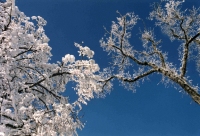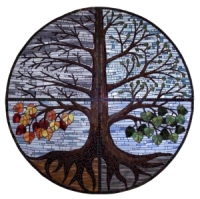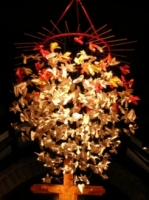|
Then
You’ll Know What I Know
| |
 |
| |
Winter Branches
By Anne Wetzel
Photograph
From the ECVA exhibition
Surprised by Joy |
| |
|
| |
|
| |
|
Photographer
Anne Wetzel has said she is frequently asked by people “how do I
see what I see” and “how do I know what to look for?” Her answer
is simple, “I just do”.
We all know
that an artist sees the world around us in a slightly different
way, something Leonardo da Vinci described as "knowing how" to
see. But how do you teach or even explain this ability to
others? This is something all art instructors must try to convey
to their students.
One can possess
great technical skills to create art, but still fail to capture
a scene or a thought. The artist must learn to go beyond the
technical aspect of creating art and develop a “feel” for
creating art. The same can be said for music. There is more to
being a musician or singer than just playing the notes or
singing the words – one must also know how to bring “feeling” to
the music.
There are many
things in life that we must learn to do, but being able to
perform the technical aspect of the task does not guarantee that
we will be good at it, or even enjoy doing it. Many people enjoy
fishing because they find it relaxing. But if you have ever
tried casting, you know that it is not a simple task. It is one
that requires practice to develop a “feel” for it. And if you
learned to drive a manual shift car, you also know that it is
more than just a matter of knowing how, but also developing a
“feel” for shifting the gears.
So what is this
“feel” for doing something? It is the mental state at which a
person no longer consciously thinks about a task, but merely
does it. And is this not true about everything we do as we go
about our daily lives. What often seems a difficult task can be
accomplished with a bit of practice and patience – and
developing a “feel” for it. Our lives today have become so
hectic, are we losing our ability for concentration, for
contemplation, for developing a “feel” for how things are done?
When Scottish
singer/songwriter Dougie MacLean wrote of his experience trying
to learn to use a scythe – the age-old tool with a long handle
and a curved blade for cutting grass and grain by hand – he
captured his father’s instructions with these words:
O this is
not a thing to learn inside a day
Stand closely by me and I'll try to show the way
You've got to hold it right
feel the distance to the ground
Move with a touch so light
until it's rhythm you have found
Then
you'll know what I know
Dan Hardison
Editor, The Episcopal Church and Visual Arts
editor@ecva.org
|



